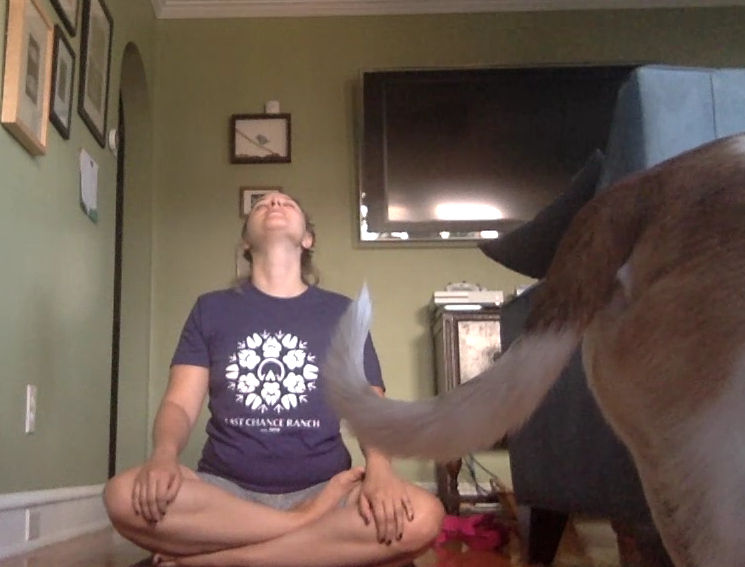Less is More - The Practice of Restriction and Repetition
- Samantha William

- May 9, 2023
- 4 min read
"Tatpratishedharthamekatattvabhyasaha''
tat = their; pratisheda = prevention; artham = for; eka = one; tattva = principle; abhyasaha = practice "For their prevention, practice one principle." - Patanjali Yoga Sūtra 32
In the Yoga Sutras of Patanjali, it is explained that when we practice one Hatha Yoga principle, “ekam tattva abyasa”, it will take us from having a cloudy mind, Chitta Vikshepa, to a clear mind, Chitta Prasad. As with all ancient texts, this can mean many things; it could mean to work through your series, it could mean practicing pranayama, or even practicing one asana including savasana. There are so many great reasons to consider this sutra. This sutra is giving us permission to do less so we can better understand the science of these ancient practices and how they apply to our own vessel and life.
There is a steadiness to repetition.
This is one of a million reasons why we repeat sun salutations. It is a repetitive moving meditation and each repetition brings more clarity, physically and mentally. We are physically clearing the clouded path with breath linked to movement. This happens to the whole microcosm as well with the vibrational (ether) quality of chanting and ujjayi breathing, or any breathing technique (Limb 4, Pranayama).
Less options = Less confusion - More options = More confusion
When we focus on one thing there is less buzzing in the mind about all of the things you could do. Having one principle to hone in on narrows our focus down (Limb 6, Dharana) which makes keeping good quality techniques more manageable. When we study hatha yoga in this way, piece by piece, we get a deep understanding of our layers (koshas) and the layers of the practice.
I love this sutra because it’s the reason we practice. To clear our clouded minds, and encourages us to deep dive into one thing - not just so we can contort our bodies. My current practice is very restricted (redirected) due to a displaced rib. No asymmetrical postures, no twisting. And because of my ongoing relationship with hyper-mobility, I’m also staying far away from my range. Thankfully all of these restrictions (redirections) leaves me with plenty to do and I’m enjoying being redirected. I have these redirections right now because I need them right now. I am grateful for this rib situation, because I wouldn’t be training my body in this way if I wasn’t taking an exploratory sidestep, and am gaining a lot of knowledge and strength that I wouldn’t have a relationship with otherwise. Being redirected has also brought me back to Second Series (which I’ve been majorly avoiding since my pregnancies) and so far it’s been a very nice fit for my body.
In my current situation my number one principle to practice has been one or all of the following:
*Pranayama (breath work)
*Chanting
*The 5 Tibetan Rites with a few symmetrical poses, usually with vinyasa’s in between.
-And/or 5 Surya namaskara A’s, a handful of symmetrical poses, inversions, savasana.
*Primary Series (symmetrical asanas only)
or
*Second Series (symmetrical asanas only)
I do what I can 6 days a week, with the time I have available on any given day. I’m loving these redirections and the support this sutra provides and feel much stronger and more symmetrical with my engagements through movement. I can feel the strength and efficiency this self study (the 4th Niyama, Limb 2, Svadhyaya) is providing on and off of my yoga mat. Only doing symmetrical asanas is heightening that specific type of self awareness leaving me better able to stay strong, balanced and centered. Coming back to this sutra supports my practice because it reminds me of the importance of diving into something until you’re beyond bored. The restlessness that comes with boredom brings clarity. Our practice can be as short or as long as suits our lifestyle. It also reminds me that to get a truly deep understanding of something, I have to be alone with it - often over a long period of time - and be present to see how it suits me as I manage my experiences through life. I need to be with a technique long enough to not have to think about it and see what thoughts come up.

What I hope you take away from my experience is that we don’t have to practice for an hour + every time we practice. Or cram in as many techniques or poses into the allotted time as possible. That’s not going to be sustainable. We practice hatha yoga techniques to empty out rather than to fill up. Sometimes (most times) less is more. And truly trying to understand something takes time, different angles of observation through a concentrated effort (Dharana). And it's ok to be bored. Stay anyway, breath, see what comes up.
A good way to work with this sutra on the mat is to begin each practice with setting a Sankalpa, an intention, to hold onto one technique (reach out if you need a suggestion), practice with that technique in the forefront. When you are wrapping up your practice, reflect on that technique practiced. How did it support you? How can that one technique continue to support you in every/any other moment of the day?
Keep practicing yogi’s!
Samantha




Comments